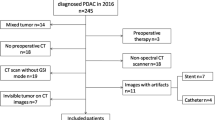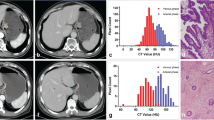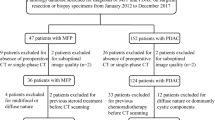Abstract
Objective
The objective of this study was to investigate the application of unenhanced computed tomography (CT) texture analysis in differentiating pancreatic adenosquamous carcinoma (PASC) from pancreatic ductal adenocarcinoma (PDAC).
Methods
Preoperative CT images of 112 patients (31 with PASC, 81 with PDAC) were retrospectively reviewed. A total of 396 texture parameters were extracted from AnalysisKit software for further texture analysis. Texture features were selected for the differentiation of PASC and PDAC by the Mann-Whitney U test, univariate logistic regression analysis, and the minimum redundancy maximum relevance algorithm. Furthermore, receiver operating characteristic (ROC) curve analysis was performed to evaluate the diagnostic performance of the texture feature-based model by the random forest (RF) method. Finally, the robustness and reproducibility of the predictive model were assessed by the 10-times leave-group-out cross-validation (LGOCV) method.
Results
In the present study, 10 texture features to differentiate PASC from PDAC were eventually retained for RF model construction after feature selection. The predictive model had a good classification performance in differentiating PASC from PDAC, with the following characteristics: sensitivity, 95.7%; specificity, 92.5%; accuracy, 94.3%; positive predictive value (PPV), 94.3%; negative predictive value (NPV), 94.3%; and area under the ROC curve (AUC), 0.98. Moreover, the predictive model was proved to be robust and reproducible using the 10-times LGOCV algorithm (sensitivity, 90.0%; specificity, 71.3%; accuracy, 76.8%; PPV, 59.0%; NPV, 95.2%; and AUC, 0.80).
Conclusion
The unenhanced CT texture analysis has great potential for differentiating PASC from PDAC.
Similar content being viewed by others
References
Kanno A, Masamune A, Hanada K, et al. Multicenter study of early pancreatic cancer in Japan. Pancreatology, 2018,18(1):61–67
Kanno A, Masamune A, Hanada K, et al. Advances in Early Detection of Pancreatic Cancer. Diagnostics (Basel), 2019,9(1):18
Boyd CA, Benarroch-Gampel J, Sheffield KM, et al. 415 patients with adenosquamous carcinoma of the pancreas: A population-based analysis of prognosis and survival. J Surg Res, 2012,174(1):12–19
Zhao R, Jia Z, Chen X, et al. CT and MR imaging features of pancreatic adenosquamous carcinoma and their correlation with prognosis. Abdom Radiol (NY), 2019,44(8):2822–2834
Toshima F, Inoue D, Yoshida K, et al. Adenosquamous carcinoma of pancreas: CT and MR imaging features in eight patients, with pathologic correlations and comparison with adenocarcinoma of pancreas. Abdom Radiol (NY), 2016,41(3):508–520
Cedeno Kelly K, Moore C. Two rare cases of pancreatic adenosquamous carcinoma: A review of the literature with focus on radiologic findings. Radiol Case Rep, 2019,14(7):809–813
Imaoka H, Shimizu Y, Mizuno N, et al. Clinical characteristics of adenosquamous carcinoma of the pancreas: A matched case-control study. Pancreas, 2014, 43(2):287–290
Lubner MG, Smith AD, Sandrasegaran K, et al. CT Texture Analysis: Definitions, Applications, Biologic Correlates, and Challenges. Radiographics, 2017,37(5): 1483–1503
Davnall F, Yip CS, Ljungqvist G, et al. Assessment of tumor heterogeneity: an emerging imaging tool for clinical practice? Insights Imaging, 2012,3(6):573–589
Kulkarni NM, Mannelli L, Zins M, et al. White paper on pancreatic ductal adenocarcinoma from society of abdominal radiology’s disease-focused panel for pancreatic ductal adenocarcinoma: Part II, update on imaging techniques and screening of pancreatic cancer in high-risk individuals. Abdom Radiol (NY), 2020, 45(3):729–742
Reinert CP, Baumgartner K, Hepp T, et al. Complementary role of computed tomography texture analysis for differentiation of pancreatic ductal adenocarcinoma from pancreatic neuroendocrine tumors in the portal-venous enhancement phase. Abdom Radiol (NY), 2020,45(3):750–758
Ren S, Zhang J, Chen J, et al. Evaluation of Texture Analysis for the Differential Diagnosis of Mass-Forming Pancreatitis From Pancreatic Ductal Adenocarcinoma on Contrast-Enhanced CT Images. Front Oncol, 2019,9: 1171
D’Onofrio M, Ciaravmo V, Cardobi N, et al. CT Enhancement and 3D Texture Analysis of Pancreatic Neuroendocrine Neoplasms. Sci Rep, 2019,9(1):2176
De Robertis R, Maris B, Cardobi N, et al. Can histogram analysis of MR images predict aggressiveness in pancreatic neuroendocrine tumors? Eur Radiol, 2018, 28(6):2582–2591
De Robertis R, Cardobi N, Ortolani S, et al. Intravoxel incoherent motion diffusion-weighted MR imaging of solid pancreatic masses: reliability and usefulness for characterization. Abdom Radiol (NY), 2019,44(1):131–139
Wang Z, Chen X, Wang J, et al. Differentiating hypovascular pancreatic neuroendocrine tumors from pancreatic ductal adenocarcinoma based on CT texture analysis. Acta radiol, 2020,61(5):595–604
Kim HS, Kim YJ, Kim KG, et al. Preoperative CT texture features predict prognosis after curative resection in pancreatic cancer. Sci Rep, 2019,9(1):17389
Schieda N, Lim RS, Krishna S, et al. Diagnostic Accuracy of Unenhanced CT Analysis to Differentiate Low-Grade From High-Grade Chromophobe Renal Cell Carcinoma. AJR Am J Roentgenol, 2018,210(5):1079–1087
Takahashi N, Takeuchi M, Sasaguri K, et al. CT negative attenuation pixel distribution and texture analysis for detection of fat in small angiomyolipoma on unenhanced CT. Abdom Radiol (NY), 2016,41(6):1142–1151
Ren S, Zhao R, Zhang J, et al. Diagnostic accuracy of unenhanced CT texture analysis to differentiate mass-forming pancreatitis from pancreatic ductal adenocarcinoma. Abdom Radiol (NY), 2020,45(5):1524–1533
Gu D, Hu Y, Ding H, et al. CT radiomics may predict the grade of pancreatic neuroendocrine tumors: a multicenter study. Eur Radiol, 2019,29(12):6880–6890
Radovic M, Ghalwash M, Filipovic N, et al. Minimum redundancy maximum relevance feature selection approach for temporal gene expression data. BMC Biomformatics, 2017,18(1):9
Chu LC, Solmaz B, Park S, et al. Diagnostic performance of commercially available vs. in-house radiomics software in classification of CT images from patients with pancreatic ductal adenocarcinoma vs. healthy controls. Abdom Radiol (NY), 2020,45(8):2469–2475
Bro R, Kjeldahl K, Smilde AK, et al. Cross-validation of component models: a critical look at current methods. Anal Bioanal Chem, 2008,390(5):1241–1251
Shieh G. Effect size, statistical power, and sample size for assessing interactions between categorical and continuous variables. Br J Math Stat Psychol, 2019, 72(1):136–154
Ren S, Qian L, Daniels MJ, et al. Evaluation of contrast-enhanced computed tomography for the differential diagnosis of hypovascular pancreatic neuroendocrine tumors from chronic mass-forming pancreatitis. Eur J Radiol, 2020,133:109360
Voong KR, Davison J, Pawlik TM, et al. Resected pancreatic adenosquamous carcinoma: clinicopathologic review and evaluation of adjuvant chemotherapy and radiation in 38 patients. Hum Pathol, 2010,41(1):113–122
Yun G, Kim YH, Lee YJ, et al. Tumor heterogeneity of pancreas head cancer assessed by CT texture analysis: association with survival outcomes after curative resection. Sci Rep, 2018,8(1):7226
Lin X, Xu L, Wu A, et al. Differentiation of intrapancreatic accessory spleen from small hypervascular neuroendocrine tumor of the pancreas: textural analysis on contrast-enhanced computed tomography. Acta Radiol, 2019,60(5):553–560
Huang Z, Li M, He D, et al. Two-dimensional Texture Analysis Based on CT Images to Differentiate Pancreatic Lymphoma and Pancreatic Adenocarcinoma: A Preliminary Study. Acad Radiol, 2019,26(8):e189–e195
Liu S, Liu S, Ji C, et al. Application of CT texture analysis in predicting histopathological characteristics of gastric cancers. Eur Radiol, 2017,27(12):4951–4959
Ahn SJ, Kim JH, Park SJ, et al. Prediction of the therapeutic response after FOLFOX and FOLFIRI treatment for patients with liver metastasis from colorectal cancer using computerized CT texture analysis. Eur J Radiol, 2016,85(10):1867–1874
Author information
Authors and Affiliations
Corresponding authors
Ethics declarations
We declare that we have no conflicts of interest.
Additional information
This study was supported by grants from the Administration of Traditional Chinese Medicine of Jiangsu Province (No. ZD201907), the National Natural Science Foundation of China (No. 82171925 and No. 81771899), the Postgraduate Research & Practice Innovation Program of Jiangsu Province (No. KYCX20_1477), the China Scholarship Council (No. 201909077001), the Jiangsu Provincial Key Research and Development Program (No. BE2017772), and the Developing Program for High-level Academic Talent in Jiangsu Hospital of TCM (No. y2018rc04).
Rights and permissions
About this article
Cite this article
Ren, S., Tang, Hj., Zhao, R. et al. Application of Unenhanced Computed Tomography Texture Analysis to Differentiate Pancreatic Adenosquamous Carcinoma from Pancreatic Ductal Adenocarcinoma. CURR MED SCI 42, 217–225 (2022). https://doi.org/10.1007/s11596-022-2535-2
Received:
Accepted:
Published:
Issue Date:
DOI: https://doi.org/10.1007/s11596-022-2535-2




